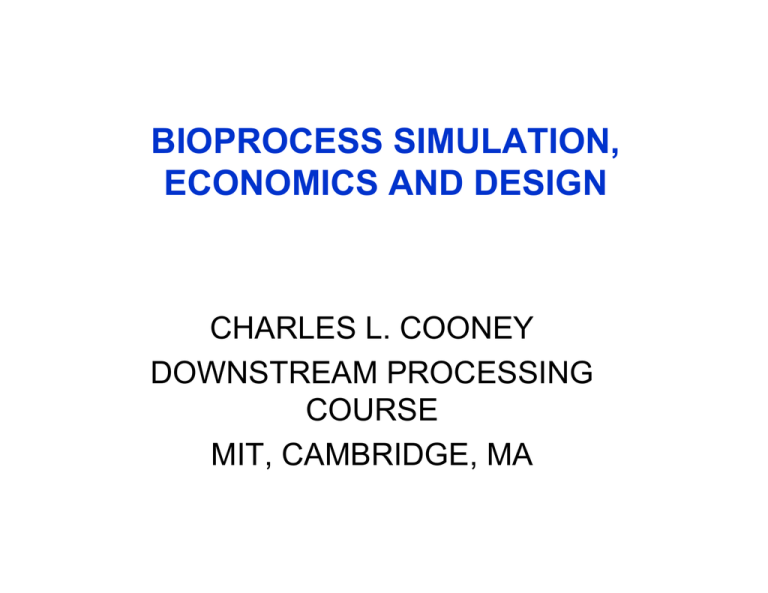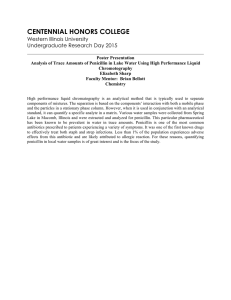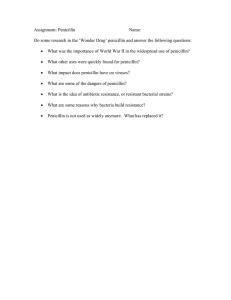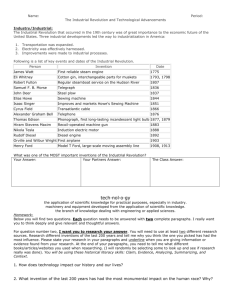BIOPROCESS SIMULATION, ECONOMICS AND DESIGN CHARLES L. COONEY DOWNSTREAM PROCESSING
advertisement

BIOPROCESS SIMULATION, ECONOMICS AND DESIGN CHARLES L. COONEY DOWNSTREAM PROCESSING COURSE MIT, CAMBRIDGE, MA PROCESS SYNTHESIS & PROCESS ANALYSIS Where do you begin Process Design? Information on Products, raw materials, etc. M&E balances, sizing, costing, economic evaluation YOUR GOAL IF YOU DON’T KNOW WHERE YOU ARE GOING AND YOU DON’T HAVE A MEANS OF MEASURING WHERE YOU ARE THEN YOU WON’T KNOW WHEN YOU ARRIVE STEPS IN PROCESS DESIGN 1. 2. 3. 4. 5. 6. 7. 8. Product definition • Product specifications • Defines analytical needs • Market size Select the synthetic technology Create process flow diagram (PFD) Material & energy balances to calculate costs • Materials (reagents and consumables) • Equipment • Utilities • Labor Assess assumptions and uncertainty Identify economic and quality hot spots Assess profitability and risk Create the R/D agenda WHAT DO I WANT & NEED TO KNOW FOR PROCESS MODELING AND SIMULATION • What is the cost of goods? • What are the cost sensitive operating parameters? • What are the assumptions and where is the uncertainty? • Where are the economic hot spots? • Where should one focus R&D? • What is the impact of process change on cost and quality? • Are there alternative processes? • Where are the process bottlenecks? • How can I increase throughput & profitability? PROFIT = VF M (S P S A − C M ) WHEN SELECTING UNIT OPERATIONS THERE ARE CHOICES AND DECISIONS MUST BE MADE Bioreactor Intracellular Extracellular Products Products Cell Harvesting 1. Centrifugation 2. Microfiltration 3. Ultrafiltration Biomass Removal 1. Vacuum Filtration 2. Centrifugation 3. Microfiltration 4. Ultrafiltration 5. Press Filtration 6. Candle Filtration 7. Flotation Cell Disruption 1. Homogenization 2. Bead Milling 3. Osmotic Shock Product Extraction By 1. Organic Solvents 2. Polymer/Polymer 3. Polymer/Salt 4. Supercritical Fluids 5. Adsorption 6. Reverse Micelles 7. Distillation Cell Debris Removal 1. Centrifugation 2. Microfiltration 3. Vacuum Filtration 4. Press Filtration Denatured Products Renaturation 1. Solubilization 2. Reoxidation High Purity Requirements Final Purification 1. Adsorption 2. Gel Filtration 3. Diafiltration 4. Electrodialysis 5. Electrophoresis Concentration 1. Ultrafiltration 2. Evaporation 3. Reverse Osmosis 4. Precipitation 5. Crystallization 6. Extraction 6. Adsorption 7. Distillation Low Purity Requirements Dehydration or Solvent Removal 1. Spray Drying 2. Freeze Drying 3. Fluid Bed Drying Contemporary Downstream Processing of Biological Materials Figure by MIT OCW. Overview Bioengineering Conversions, Yields Raw Materials Utilities Labor Consumables Operating Costs Process Flow Diagram Volume/Mass of Product Equipment prices Purchase Equipment Cost Multipliers Capital Investment CASE STUDIES • Protein synthesis using mammalian cells for Monoclonal Antibody production • Microbial process producing the antibiotic Penicillin • Alkaline Protease production by microbial fermentation CASE OBJECTIVES •Flowsheet formulation •Material and energy balances •Equipment size estimation •Estimation of capital costs •Estimation of operating cost •Profitability •Assay for the process Monoclonal Antibodies • In vitro use (antigen identification, antigen purification) • In vivo use (therapeutic applications, diagnostic tools) • Growing market: 2,400 kg in 2006 (Chovav et al., 2003) • New MAb entering the market; in the biopharmaceutical development pipeline • Need for new production facilities and optimization of existing plants Chovav et al.: The state of biomanufacturing; UBS's Q-series: London, 2003. Penicillin V O H H O S N H CH3 CH3 N O • Hydrophobic β-lactam • Produced by Penicillium chrysogenum • Penicillin G and V main penicillins of commerce • Used a human medicine and in animal health • Further processed to semi-synthetic penicillins • Annual production penicillin: 65,000 tons • Price penicillin V: $11/BU, or $17-18/kg CH3 1. Estimation of Capital Investment Types of Cost Estimates Study estimate (+/- 30%) Preliminary estimate (+/- 20%) Definitive estimate (+/- 10%) Detailed estimate (+/- 5%) Accuracy Stage of Development Order-of-Magnitude estimate (> +/- 30%) Equipment Size and Cost Bioengineering Process Flow Diagram Fermenter Volume/ Mass of Product Equipment prices Purchase Equipment Cost Fermenter Size/ Amount of Product Plant size can be derived from: • Volume and number of fermenters • Annual amount of product to produce Decision based on: • Market Volume • Technical feasibility • Own business plan / competitor Process Flow Diagram: Penicillin S-101 S-105 S-117 S-102 P-8 / AF-102 S-116 S-103 S-104 S-106 P-1 / V-101 S-111 P-3 / MX-101 Blending / Storage Medium S-107 Air Filtration S-109 S-150 P-4 / ST-101 S-112 Heat Sterilization Mixing S-110 S-118 P-20 / RVF-101 S-119 S-108 S-115 P-2 / V-102 P-21 / HX-101 Cooling S-153 P-9 / V-106 Fermentation Storage Blending / Storage Glucose P-6 / AF-101 S-114 S-164 Air Filtration S-161 S-155 P-22 / MX-102 P-5 / G-101 S-158 S-160 Gas Compression S-163 S-166 Centrifugal Extraction P-24 / MX-104 S-174 Neutralization S-165 P-25 / V-104 S-162 S-159 Re-ectraction + Crystallization S-175 P-31 / FBDR-101 S-168 S-173 Fluid Bed Drying P-26 / BCF-101 S-156 Basket Centrifugation S-172 P-29 / MX-103 Adding Fresh Butyl Acetate P-27 / CSP-101 S-169 S-171 Component Splitting P-32 / V-105 Storage Penicillin Sodium Salt S-178 Acidification P-23 / CX-101 S-167 S-176 S-177 S-152 Removal Biomass P-7 / V-103 S-113 S-151 S-170 P-28 / MX-105 Neutralization S-157 S-154 Equipment Cost • Costs for major pieces of equipment in PFD • Prices obtained from: – Vendor quotations – Previous projects – Literature (e.g. Peters et al.) – Default values simulation software • Cost estimate for unlisted equipment Peters, M., Timmerhaus, K. and West, R.: Plant design and economics for chemical engineers; McGraw Hill: Boston, 2003. Price Indices • Purpose: To estimate cost data from previous projects, analogous sources, different times, etc. • Most frequently used Prices Indices: – Marshall & Swift Index (M&S Index) – Chemical Engineering Index • Estimating the cost: Present cost = (original cost) x (Index value Today) (Index value at time original cost was obtained) Total Plant Direct Cost Purchased Equipment Cost (PC) $ 12.4 Million Installation 1.0 = 12.4 Process Piping 0.75 = 9.3 Instrumentation 0.8 = 9.9 Insulation 0.05 = 0.6 Electrical 0.15 = 1.9 Buildings 2.5 = 31.0 Yard Improvement 0.15 = 9.9 Auxiliary Facilities 0.8 = 10.7 Total Plant Direct Cost X(PC) $ 89.3 Million Direct Fixed Capital Investment Total Plant Direct Cost (TPDC) Engineering 0.25 Construction 0.35 X(TPDC) $ 89.3 Million = 22.3 = 31.2 Total Plant Indirect Cost (TPIC) $ 53.6 Million Total Plant Cost = TPDC + TPIC $ 142.8 Million Contractor’s Fee 0.06 Contingency 0.1 Direct Fixed Capital X(TPC) = 8.6 = 14.3 $ 165.7 Million Total Capital Investment Direct Fixed Capital (DFC) Start up/Validation cost 0.05 DFC Working Capital: 30 days* Total Capital Investment (TCI) $ 165.7 Million = 8.3 = 0.7 $ 174.7 Million * Covering labor, raw material, utilities and waste treatment cost Economy of Scale • Six-Tenth Factor: Derived from statistical/empirical data K2 = K1 (P2/P1)0.6 K = investment cost; P = annual capacity • Example: MAb: • 381 kg MAb per year, $175 Million investment cost • Estimated investment cost for a 500 kg plant: K2 = 175 (500/381)0.6 = $206 Million Penicillin: Equipment Purchase Costs Cost ($ million) Purchase costs Basket Centrifuge Crystallization Unit Compressors Air Filters Fermenters Heat Sterilizer Blending Tanks Rest 0.0 1.0 2.0 3.0 4.0 5.0 6.0 MAB: Allocation Equipment Cost to Sections Purchased Equipment Cost Final Filtration $ million HIC Ion Exchange Chr. Protein A Chr. Primary Recovery Bioreaction Inoculum Preparation 0.0 0.5 1.0 1.5 2.0 2.5 2. Estimation Operating Cost Process Diagram Consumables Consumables Raw Materials Utilities Labor Bioreaction Waste Downstream Processing Waste Final Product Raw Material Costs • Amount of a compound x its Price • Possible sources: – – – – Supplier Internal data Literature, e.g. Chemical Market Reporter Sales catalogues • Pricing is very dependent on source and volume Consumables • Factors: – Amount per batch – Replacement frequency/ operating hours – Price • Sources of data: – – – – Experiments Supplier data Literature, default value simulation software Estimates by analogy • Major consumables: – adsorption/chromatography resins – membranes (filtrations, dialysis, diafiltration etc.) Waste • Waste treatment normally not part of the PFD • Waste types and costs* – Solid waste: • Non-hazardous: $35/ton • Hazardous: $145/ton – Liquid waste/wastewater: $0.5/m3 – Emissions: cost depend on composition • Treatment mandated by environmental laws *Peters, M., Timmerhaus, K. and West, R.: Plant design and economics for chemical engineers; McGraw Hill: Boston, 2003. Energy Consumption • Typical energy consumptions: – – – – – Process heating & cooling HVAC Evaporation/distillation Bioreactor aeration, agitation Centrifugation, cell disruption, etc. • Utility costs: – Electricity: 4.5 ct/kWh – Steam: 4.40 $/ton – Cooling water: 8 ct/m3 Labor Cost • Amount of labor: – Calculated from demand for each process step – Defines the number of people per shift/number of shifts • Hourly cost – Internal company average value – Literature, e.g. Peters et al. (2003): skilled labor: 34 $/h – Bureau of Labor Statistics (www.bls.gov) Depreciation • Depreciation cost = “pay back” of investment cost • Depreciation period ≈ Life time of project: 3-10 years • Depreciation method: – Straight line (same $ every year) – Declining balance, e.g. MACRS Facility-Dependent Costs: MAb Direct Fixed Capital (DFC) $ 165.7 Million Insurance 0.015 = 2.5 Local Taxes 0.025 = 4.1 Contractor’s Fee 0.055 = 9.1 Maintenance 0.06 = 9.9 = 16.6 Depreciation period Depreciation DFC 10 years 0.10 TCI Annual Facility-Dependent Cost $ 42.3 Million Operating Cost MAb Raw Materials 3.5 Consumables 8.2 Total Labor Cost (TLC) 3.9 Utilities 0.024 Laboratory/QC/QA 0.6 TLC = 2.3 Waste Treatment/Disposal 0.006 Facility-Dependent Costs 42.3 Operating Cost $ 60.3 Million 3. Uncertainty Analysis Uncertainty Analysis Process Data, Literature, Estimates Environmental Assessment Process Model (SuperPro Designer) Economic Assessment Uncertainty Analysis Scenarios Monte Carlo Simulations Sensitivity Analyses Penicillin: Worst + Best Case Scenario Worst Case Base Case Best Case Unit production Cost [$/kg] 28.0 16.0 10.5 EBITDA [$ million] -18 4.0 31 Objective Functions Scenarios based on chosen minimum and maximum values for input variables Monte Carlo Simulation Uncertain variables: Technical parameters e.g. product concentration Objective functions: S-10 S-10 Environmental Indices S-11 S-10 P-8 / AF-1 S-11 S-10 S-10 P-1 / V-1 S-10 S-15 S-11 P-4 / ST-1S-11 P-3 / MX-1 Heat Sterilizat Mixing Blending / Storage Me S-10 Air Filtratio S-10 S-11 S-11 Removal Biom P-7 / V-1 S-11 Supply chain parameters e.g. media price P-21 / HX-1 Coolin S-15 P-9 / V-1 Fermentati Storag Blending / Storage Glu S-11 S-15 P-20 / RVF- S-11 S-10 P-2 / V-1 S-15 P-6 / AF-1 S-11 S-16 Air Filtratio Monte Carlo simulations S-16 S-15 P-22 / MX-1 P-5 / G-1 Gas Compres P-23 / CX-1 S-16 S-17 Acidificatio S-15 S-15 S-16 Centrifugal Extrac S-16 S-16 Unit Production Cost P-24 / MX-1 S-17 S-16 P-25 / V-1 S-16 Neutralizati S-15 S-15 Re-ectraction + Crystall S-17 P-31 / FBDR- S-17 S-16 S-17 Fluid Bed Dry P-26 / BCF- S-15 Basket Centrifuga S-17 P-29 / MX-1 Adding Fresh Butyl Ac P-27 / CSP- Market parameters e.g. product selling price S-16 S-17 Component Split P-32 / V-1 S-17 Storage Penicillin Sodium S-17 P-28 / MX-1 Neutralizati Return on Investment Penicillin: Parameters for Monte Carlo Simulation • Yield biomass on glucose • Maintenance coefficient (glucose) • Precursor utilization efficiency • Downstream recovery yields (each step) • Recycling yields: butyl acetate, acetone • Final biomass concentration • Price glucose • Final production concentration • Price phenoxyacetic acid • Aeration rate • Electricity cost ($/kWh) • Agitator power • Selling price product Probability Distribution: Input Variables 0.0300 0.0200 0.0100 0.0000 44.6 52.3 60.0 67.6 75.3 Final product concentration: Normal distribution, Std.-Dev.: 10% 0.0200 Agitator power: Normal distribution, Std.-Dev.: 20%, min: 1.5 kW/m3, max: 3.5 kW/m3 0.0150 0.0100 0.0050 0.0000 1.5 1.9 2.3 2.7 3.1 0.0250 0.0200 0.0150 0.0100 0.0050 0.0000 Price glucose: Beta distribution, α = 3.49; β = 1.2, Distribution type fits best actual data 2.1 7.6 13.0 18.4 23.8 Probability Distribution UPC: Technical Parameters 3500 3000 Frequency 2500 2000 1500 1000 500 0 12.1 14.5 16.9 19.3 UPC ($/kg) 21.7 Probability Distribution UPC Unit Cost 0.14 Supply chain/market par. 0.12 all parameters pen concentration only probability 0.1 Tech. Par. without pen conc. 0.08 0.06 0.04 0.02 0 10.0 12.5 15.0 17.5 UPC [$/kg] 20.0 22.5 25.0 Production of Alkaline Protease for Detergent Use Alkaline protease is an important additive for use in laundry detergents. The objective is to simulate the operation of a plant to produce 6,000 ton/y of crude enzyme (e.g. containing 250 tpa of pure protein). The plant will use five (5) 150 m3 fermentors and operate with a 75 h process cycle time. Production of Alkaline Protease Fermentor Hold Tank Flocculant Addition Membrane Filtration Rotary Vacuum Filtration pH or salt adjustment Crystallization Figure by MIT OCW. Average Flowrate (kg/hr) Alkaline Protease 20000 15000 10000 5000 0 T102 VF201 UF202 SD401 SW502 0.8 0.4 0.0 T102 VF201 UF202 SD401 SW502 40 Specific Activity (solids wet basis) Product Yield 1.2 30 20 10 0 T102 VF201 UF202 SD401 SW502 Figure by MIT OCW. Improving Titer 1000 Product cost ($/kg) 800 600 400 200 0 1 2 3 4 5 6 Initial enzyme concentration (g/l) Figure by MIT OCW. 7 WHERE ARE THE PROBLEMS? •INADEQUATE ANALYTICAL TECHNIQUES •SIMPLISTIC MODELS WITH ASSUMPTIONS •VARIANCE IN SIGNALS AND PERFORMANCE •INEFFICIENCIES IN USE OF INFORMATION •INEFFICIENT LEARNING






